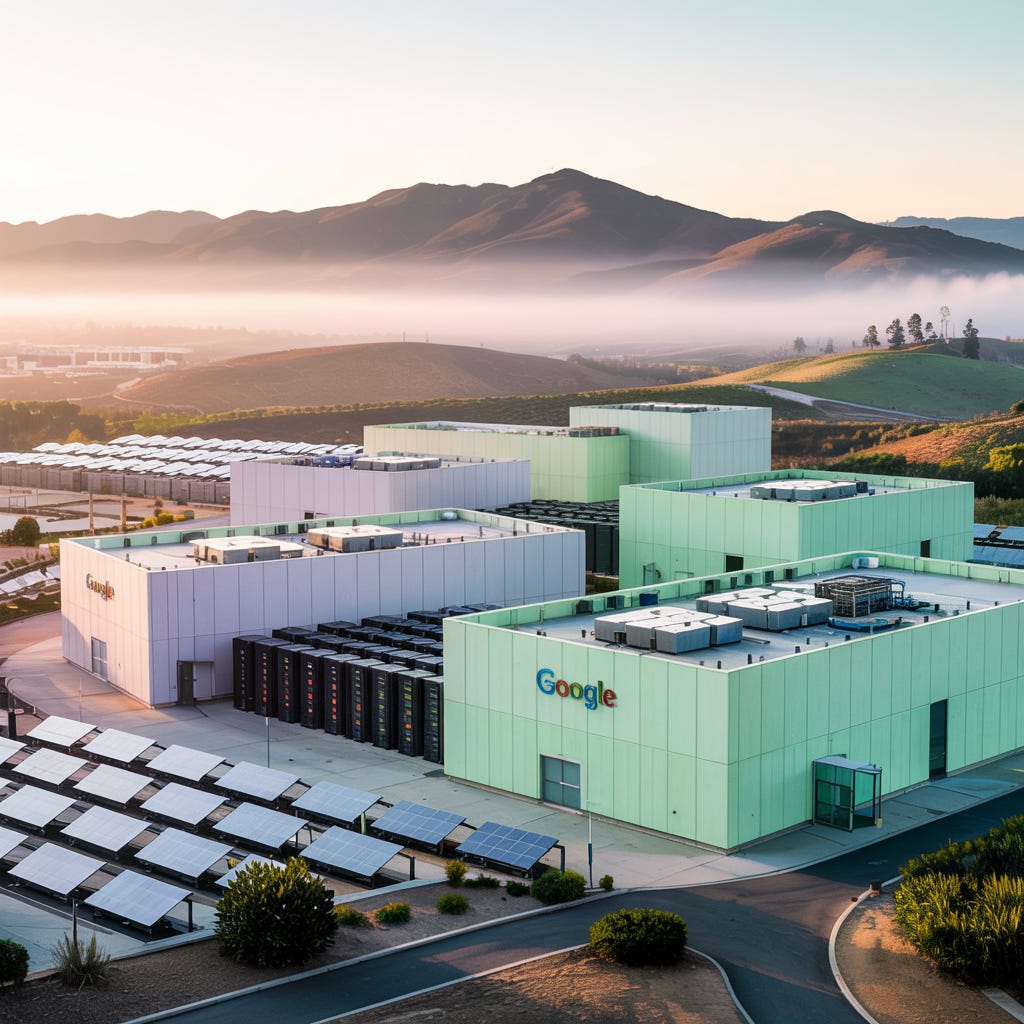Google Q3 2025: $93 Billion CapEx Marks the Moment AI Became Infrastructure
A record quarter. A $93 billion CapEx plan. And a clear signal that AI infrastructure not advertising is now Alphabet’s core business.
Welcome to Global Data Center Hub. Join investors, operators, and innovators reading to stay ahead of the latest trends in the data center sector in developed and emerging markets globally.
Alphabet’s third-quarter results marked the most consequential phase shift in the company’s history. What began as a digital platform anchored in Search and advertising is now becoming the world’s largest integrated AI infrastructure operator.
Revenue surpassed $100 billion for the first time, rising 16 percent year-over-year to $102.3 billion, while net income advanced 33 percent to $35 billion and earnings per share reached $2.87 a 35 percent increase. Beneath those headline results sits a deeper story: a full-year CapEx program lifted again to $91–93 billion, Alphabet’s third upward revision of 2025, confirming that AI at global scale is no longer a product cycle but a utility build-out.
The company is channeling its extraordinary cash generation into the physical substrate of computation chips, power systems, and fiber corridors designed to sustain multi-year AI demand across continents. This is a decisive transition from optimizing algorithms to owning the energy, silicon, and real estate that define capacity.
Earnings and Infrastructure Strategy
Alphabet’s core franchise remains immensely profitable, financing one of the most ambitious technology build programs ever attempted by a private company.
Google Services delivered $87.1 billion in revenue, up 14 percent, driven by Search, YouTube, and the expansion of its 300 million-plus subscription base. AI Overviews and AI Mode expanded total query volume, setting up future monetization once ad formats mature.
Google Cloud continued to be the structural growth engine. Revenue climbed 34 percent to $15.2 billion, with operating income surging 85 percent to $3.6 billion. The backlog increased 46 percent quarter-over-quarter to $155 billion, a figure that now represents reserved AI compute contracts spanning multiple years. More billion-dollar deals have been signed in 2025 alone than in the prior two years combined. Nine of the top ten AI research labs now run workloads on Google Cloud, embedding the platform into the core of global model development.
Quarterly CapEx reached $23.9 billion, roughly 49 percent of operating cash flow, preserving superior capital efficiency relative to peers. Two-thirds of that spend went toward GPUs, TPUs, and servers, with the balance directed to new data-center campuses, high-voltage substations, and optical-fiber networks. The deployment rate signals an unprecedented acceleration in global compute provisioning.
Regional Expansion and Data-Center Buildout
Alphabet’s infrastructure expansion is broad-based, spanning every major geography where demand for AI processing is accelerating.
North America remains the nucleus of capacity, with multi-campus projects underway in Virginia, Texas, and Ontario. These facilities will add hundreds of megawatts by 2026 and are co-located with renewable generation and long-haul fiber links to support low-latency AI workloads.
In Europe, growth continued despite persistent regulatory friction. Alphabet is extending sovereign-cloud and compliance-aligned zones in Germany, France, and the Nordics, integrating high-efficiency liquid cooling and grid partnerships tied to renewable PPAs.
Asia-Pacific has emerged as the company’s fastest-expanding theater. India now anchors the region’s consumer and enterprise growth; Gemini adoption there exceeds 100 million monthly users, while new campuses in Japan, Singapore, and Australia expand training and inference capacity.
In Latin America, Alphabet is scaling its enterprise cloud presence through long-term contracts in Brazil, Chile, and Mexico. Each site is being designed for AI-optimized density and direct-to-chip cooling, enabling rapid commissioning once local power approvals are secured.
Collectively, these projects represent more than 1.5 gigawatts of new data-center power either under construction or committed, establishing Alphabet as one of the largest single private builders of digital-energy infrastructure worldwide.
Power, Land, and Capacity Planning
Energy availability now defines Alphabet’s competitive frontier. The 2025–2026 CapEx cycle is focused on securing grid access, renewable supply, and land for expansion across multiple continents. Management’s disclosures suggest that the company’s active pipeline combining owned campuses and leased interconnect sites could exceed 2 gigawatts of energized capacity by late 2026, effectively doubling today’s footprint.
Alphabet’s seventh-generation Ironwood TPU enters general availability this fiscal year, while large-scale A4X Max GPU instances powered by NVIDIA GB300 chips are now shipping to enterprise customers. The integration of these custom and third-party processors into unified clusters allows for higher compute density and greater energy efficiency.
Parallel to AI, the company’s Willow quantum chip achieved verified algorithmic performance 13,000 times faster than one of the world’s leading supercomputers signaling a long-term bet on post-classical compute. Combined with renewable PPA commitments, Alphabet’s data center design now marries high-density silicon with low-carbon power at unprecedented scale.
Forecast and Strategic Outlook
Alphabet’s Q3 2025 results redefine what it means to compete in AI. The company’s balance sheet is no longer a buffer it is a barrier to entry. Every incremental dollar of capital is converting into long-duration capacity, reinforcing a cycle where scale creates demand and demand justifies scale.
The short-term implication is margin pressure, as AI Search and Cloud compute carry higher energy and depreciation costs. The long-term outcome is strategic autonomy: control over the world’s AI capacity, latency, and energy sources. With CapEx approaching $93 billion this year and likely to rise again in 2026, Alphabet now sits alongside Microsoft and Amazon as a defining force in AI infrastructure.
This quarter was not a financial beat it was an industrial announcement. Alphabet has crossed the threshold from AI applications to AI infrastructure at global scale. If the company continues to energize capacity as quickly as it books it, it will end the decade not as a platform provider but as the utility that powers the AI economy.

